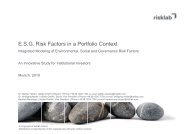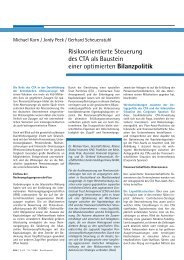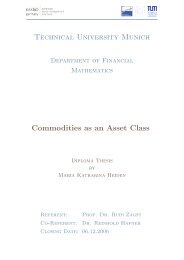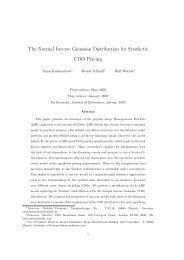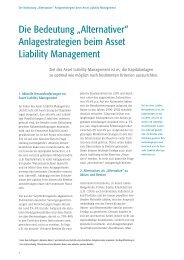Technische Universität München Credit as an Asset Class - risklab
Technische Universität München Credit as an Asset Class - risklab
Technische Universität München Credit as an Asset Class - risklab
Create successful ePaper yourself
Turn your PDF publications into a flip-book with our unique Google optimized e-Paper software.
CHAPTER 2. CREDIT RISK TRANSFER<br />
tailored for the specific needs of a market particip<strong>an</strong>t. Thus, they help investors to better<br />
m<strong>an</strong>age their credit risk exposure. They also allow for synthesising <strong>as</strong>sets that would not<br />
be available for certain investors or that even do not exist.<br />
<strong>Credit</strong> derivatives are also used for the purpose of speculation. A market particip<strong>an</strong>t<br />
does not need to have <strong>an</strong> exposure to a debt instrument to enter into a credit derivative<br />
contract. <strong>Credit</strong> derivatives c<strong>an</strong> rather be used to express one’s opinion about future<br />
credit quality of a reference entity, <strong>an</strong>d that way to fin<strong>an</strong>cially participate in its ch<strong>an</strong>ges<br />
by trading these instruments. For the investor, the underlying itself is irrelev<strong>an</strong>t. He is<br />
only interested in generating a profit from trading.<br />
Another kind of market particip<strong>an</strong>t is <strong>an</strong> arbitrageur, who tries to benefit from pricing<br />
differences in two or more markets.<br />
2.3.4 Ch<strong>an</strong>ces <strong>an</strong>d Risks related to <strong>Credit</strong> Derivatives Markets<br />
The credit derivatives markets incorporate both ch<strong>an</strong>ces <strong>an</strong>d risks, which are described in<br />
this section.<br />
Ch<strong>an</strong>ces related to <strong>Credit</strong> Derivatives Markets<br />
On a microeconomic level, credit derivatives are instruments for credit risk tr<strong>an</strong>sfer, partly<br />
comparable to traditional instruments for credit risk tr<strong>an</strong>sfer such <strong>as</strong> lo<strong>an</strong> sale or credit<br />
insur<strong>an</strong>ce. The characteristics of the derivatives <strong>an</strong>d their possible applications, however,<br />
go far beyond those of the traditional instruments such <strong>as</strong> lo<strong>an</strong> sales <strong>an</strong>d credit insur<strong>an</strong>ce.<br />
<strong>Credit</strong> derivatives allow b<strong>an</strong>ks to isolate <strong>an</strong>d to trade credit risks <strong>as</strong> well <strong>as</strong> to dynamically<br />
adjust their credit risks, <strong>an</strong>d thus optimising their risk profile.<br />
On a macroeconomic level, the utilisation of credit derivatives c<strong>an</strong> contribute to im-<br />
prove the overall risk allocation within fin<strong>an</strong>cial systems, which c<strong>an</strong> be accomplished in the<br />
following ways: First, b<strong>an</strong>ks are enabled to perform risk m<strong>an</strong>agement in a more flexible<br />
<strong>an</strong>d efficient way. Second, the incre<strong>as</strong>ed trading activities improve the tr<strong>an</strong>sparency <strong>an</strong>d<br />
the quality of the pricing. Third, credit risk is distributed more efficiently. Hence, the<br />
aggregated risk within a national economy is reduced <strong>an</strong>d market crises c<strong>an</strong> be better ab-<br />
sorbed <strong>as</strong> risks <strong>an</strong>d possibly implied damages are less concentrated. All in all, the stability<br />
of the fin<strong>an</strong>cial system c<strong>an</strong> be incre<strong>as</strong>ed. 25<br />
Risks related to <strong>Credit</strong> Derivatives Markets<br />
We examine the risks induced by credit derivative contracts. Table 2.1 gives <strong>an</strong> overview<br />
on the possible risks inherent in credit derivatives markets.<br />
The risks related to the credit derivatives markets c<strong>an</strong> be cl<strong>as</strong>sified into two groups:<br />
Risks on contract level <strong>an</strong>d risks on market level. At first, we explain the risks on contract<br />
level.<br />
• Counterparty risk – risk that one of the counterparties (protection seller or buyer)<br />
is unable to fulfil its contractual obligations.<br />
25 See [DBR04], pp. 1-3 <strong>an</strong>d [Deu04], pp. 36-37.<br />
15



